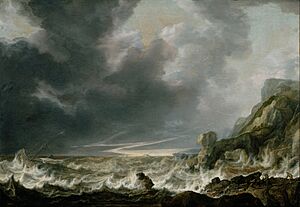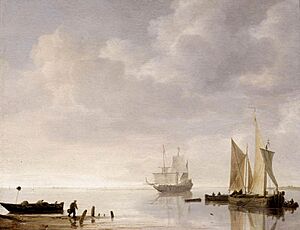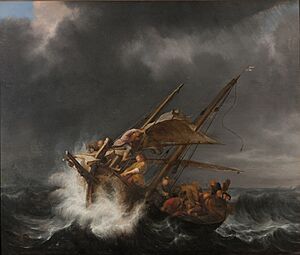Simon de Vlieger facts for kids
Simon de Vlieger (born around 1601, died 1653) was a famous Dutch artist. He was a painter, a draughtsman, and he designed many things. These included tapestries, etchings, and stained glass windows. He is most famous for his paintings of the sea. But he also painted scenes of beaches, landscapes, and everyday life.
Life of Simon de Vlieger
Simon de Vlieger was likely born in Rotterdam, a city in the Netherlands. His father was Jacob Pietersz van Zwet Bolleweck. Simon had a sister named Neeltje de Vlieger, who also became a painter. We don't know who taught Simon how to paint.
He got married in Rotterdam in 1627 to Anna Gerrits van Willige. They had a daughter named Cornelia. She later married another painter, Paulus van Hillegaert II.
In 1634, Simon de Vlieger moved to Delft. He rented a house there for about a year. After that, he moved to another house called 'De Houttuyn'. He also joined the Guild of Saint Luke in Delft. This was a special group for artists.
He moved to Amsterdam in 1638. There, he worked on paintings for Queen Maria de' Medici's visit. This job lasted until 1642. He also made drawings in other towns, like Arnhem and Kleef. From 1642 to 1644, he worked in Rotterdam. He helped paint the organ shutters for the St Laurens church. Even with all this travel, he kept his home in Amsterdam. He became a citizen of Amsterdam in 1643. In 1650, he moved to Weesp, a small town near Amsterdam. He passed away there in 1653.
A famous painter named Willem van de Velde the Younger was one of Simon de Vlieger's students.
Simon de Vlieger's Artworks
Simon de Vlieger is best known for his marine paintings. These are paintings of the sea, ships, and coasts. But he also painted scenes of beaches, landscapes, and everyday life. Besides painting, he designed tapestries, etchings, and stained glass windows. He made windows for the Nieuwe Kerk in Amsterdam. He also designed organ shutters for the St. Laurenskerk in Rotterdam. Simon de Vlieger signed his art with "S.D.VL.F.", which meant "Simon de Vlieger made this."
His earliest known paintings are from 1624. These sea paintings were similar to the works of Jan Porcellis. They often showed many ships and rocky coasts. In the 1630s and 1640s, he became one of the most famous Dutch sea painters. He started using more realistic colors in his art. He also painted ships with great detail and accuracy. He showed ships in harbors, at sea, and even during storms. He also painted shipwrecks.
When he lived in Delft, de Vlieger painted many sea scenes. These often showed the sea crashing against a rocky shore. One example is his painting Calming the storm from 1637. This painting shows a boat in a storm. The way he painted the boat was inspired by an old print. But de Vlieger made the story fit into the whole sea scene. He didn't just focus on the people in the boat.
De Vlieger was very good at showing ships in detail. He could also paint the colors of the seawater very realistically. He painted entire fleets of ships and even naval battles. His sketches show that he understood how to use linear perspective. This made his paintings look very deep and real.
Around 1630, de Vlieger painted his first beach scene. He painted many more of these over the next twenty years. From 1650 until he died, he mostly painted and drew sea coasts and forests.
His art had a big impact on younger sea painters. Other artists, like Jan van Ossenbeeck, copied his work. Aelbert Cuyp also learned from de Vlieger. Cuyp copied de Vlieger's way of painting Dutch skies. These skies often had clouds and sun rays shining through them.
Images for kids
See also
 In Spanish: Simon de Vlieger para niños
In Spanish: Simon de Vlieger para niños





